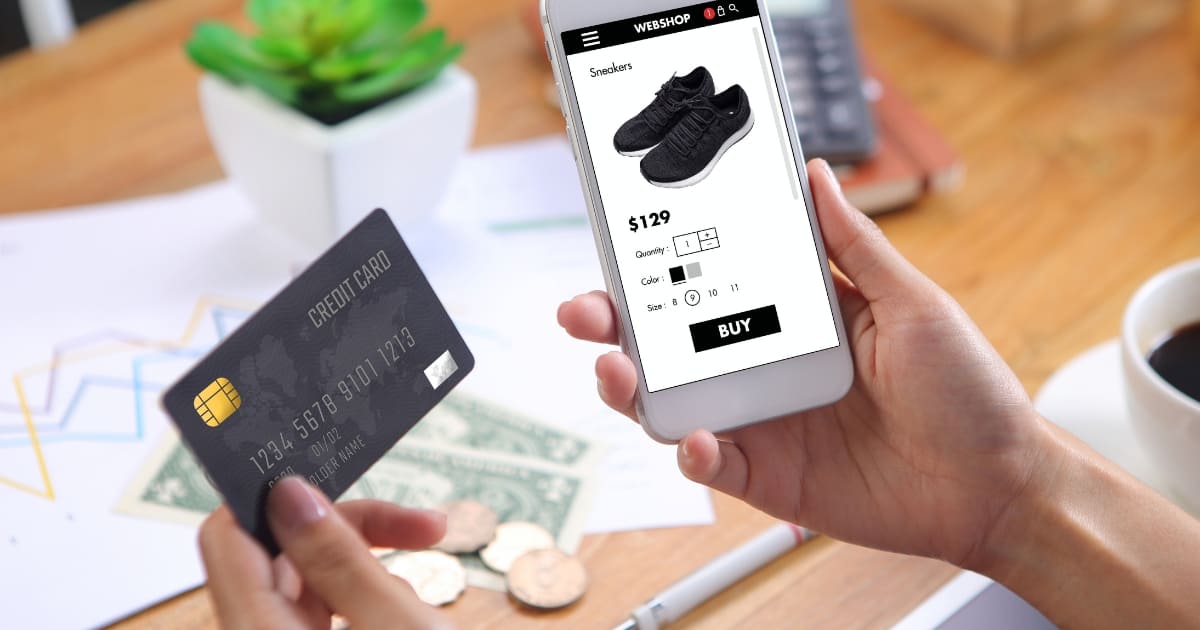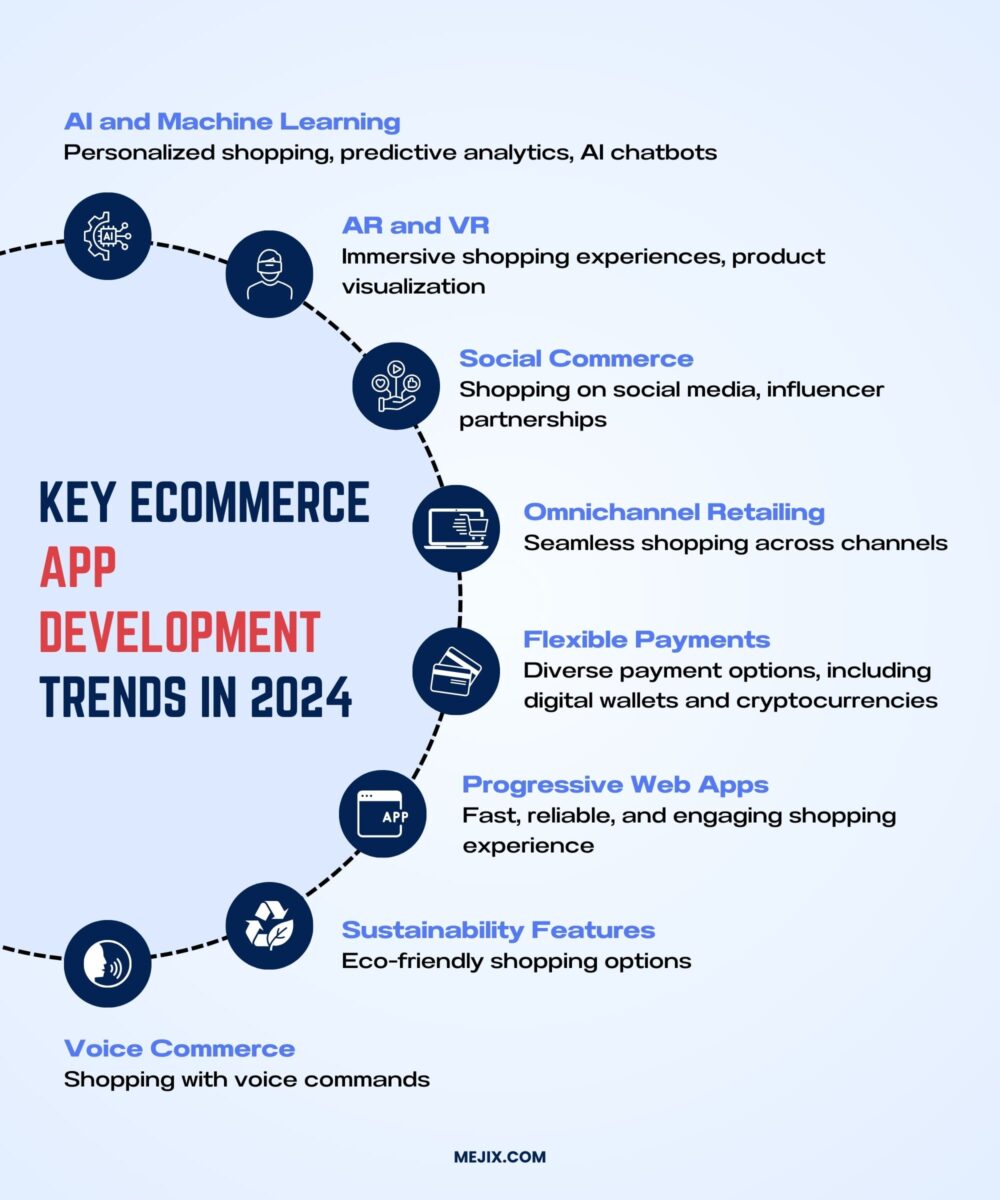Top E-commerce App Development Tips in 2024 – How to Build a Successful Online Marketplace
The landscape of online marketplaces is continuously shifting, with new technologies and user expectations shaping e-commerce app development. Today, we’re witnessing the rise of innovative and efficient apps prioritizing robust functionality, seamless user experience, and cutting-edge technology.
Today, we explore the key steps to creating an effective e-commerce mobile or web app for your business and the emerging trends and technologies to watch for in 2024.
The Rise of Online E-Commerce

Since the pandemic, online shopping has been rapidly expanding, with mobile and web apps becoming an essential part of how customers shop.
According to Business of Apps, in 2023, e-commerce app revenue reached $3.88 trillion, increasing by an impressive 8.1% compared to the previous year. In the US alone, 7.6% of total retail came from mobile commerce.
This upward trend shows no signs of slowing down, giving businesses even more reasons to embrace mobile commerce.
As mobile technology continues to evolve, businesses that invest in mobile commerce will be better positioned to meet consumer demand and stay competitive in the digital marketplace.
Key Steps to E-commerce App Development

1. Define Your Objectives and Target Audience
Start by clearly defining the objectives of your e-commerce app. Are you aiming to increase sales, enhance customer engagement, or expand into new markets? Your goals will shape the features and design of your app.
Here is where thorough market research comes in – it will help you understand your potential users’ preferences, behaviors, and needs. Tailoring your app to meet these needs will improve user satisfaction and increase engagement.
2. Choose the Right Platform
The right platform for your needs depends on various factors, such as your budget, business requirements, and technical expertise.
Decide whether to develop a native app for iOS and Android or use a cross-platform framework. Native apps offer better performance and user experience, while cross-platform development can reduce costs and speed up development.
3. Design an Intuitive User Interface
User experience is critical to a successful e-commerce app. You want to create a seamless, intuitive, and pleasing customer journey.
Prioritize creating a user-friendly interface. A seamless UX design will ensure users can easily navigate your app, find products, and complete purchases.
Incorporate modern design elements that reflect the brand’s identity. High-quality images, engaging graphics, and a consistent color scheme will enhance your app’s overall aesthetic.
Additionally, ensure coherence between mobile and web apps, so users experience the same level of ease and familiarity, whether they’re shopping on a desktop or a mobile device. This consistency helps build brand trust and loyalty.
4. Develop Essential Features
Here are some must-have features for a robust, easy-to-use mobile-commerce app:
- Product Catalog: Implement a comprehensive product catalog with features such as filtering, sorting, and detailed product descriptions.
- Shopping Cart and Checkout: Design a streamlined shopping cart and checkout process. Ensure the checkout process is simple and secure and supports various payment methods to reduce cart abandonment.
- User Accounts and Personalization: Enable user accounts for personalized shopping experiences, including order tracking, wishlists, and tailored product recommendations. Push Notifications: Integrate push notifications to inform users about promotions, order updates, and other relevant information.
5. Integrate Secure Payment Gateways
When it comes to digital payments, users prefer having various payment options. This can include credit/debit cards, digital wallets, cryptocurrencies, and buy-now-pay-later services.
Implement robust security measures to protect payment information and user data. This includes encryption, secure payment gateways, and compliance with industry standards such as PCI-DSS.
6. Focus on Performance Optimization
In today’s dynamic digital age, there’s nothing more frustrating than getting stuck on a loading page. Ensure that your app loads quickly and performs efficiently. Optimize images, use caching techniques, and streamline code to enhance performance.
Build your app with scalability in mind to handle increasing traffic and transactions as your business grows. Choose a reliable hosting provider and optimize your backend infrastructure for scalability.
7. Conduct Thorough Testing
Before launch, prioritize various types of testing, including functional, usability, performance, and security testing.
Conducting beta testing with a select group of users will help you gather feedback and make improvements based on real-world usage.
8. Launch and Market Your App
A successful marketing strategy is crucial to your app’s success. Plan a strategic launch to create buzz and attract initial users.
Optimize your app store listing with relevant keywords, compelling descriptions, and high-quality screenshots to increase visibility and downloads.
9. Monitor and Analyze E-commerce App Performance
-
Define E-commerce App Goals and KPIs – Set measurable KPIs like user retention, conversion rates, and average order value to track success.
More on setting KPIs for e-commerce apps -
Use Analytics Tools – Track user behavior, app speed, and key metrics using tools like GA4 E-commerce tracking or Mixpanel
Explore analytics tools for e-commerce apps -
Collect User Feedback – Use surveys and in-app reviews to gather insights for continuous improvement.
Learn about collecting user feedback -
Run Usability Tests – Identify and fix pain points in navigation and checkout through usability testing.
More on e-commerce app usability testing -
Implement A/B Testing – Test and optimize key features like product pages and checkout for better performance.
Read more on A/B testing for e-commerce apps
10. Provide Ongoing Support and Maintenance
Reliable customer support is paramount for customer satisfaction. In-app chat support, email assistance, or a comprehensive FAQ section can help users with any problems.
Keep your app up to date with regular maintenance and updates. Address bugs, improve features, and be mindful of technological advancements – these steps will help you maintain user satisfaction in the long run.
Key Ecommerce App Development Trends in 2024

This year’s eCommerce app trends are all about hyper-personalized experiences, new technologies, and smart integrations. Let’s look at some of the top app development trends in 2024:
1. AI and Machine Learning Integration: AI and machine learning technologies offer personalized shopping experiences, predictive analytics, and enhanced customer service through AI-powered chatbots.
For example, Amazon’s recommendation engine uses machine learning to suggest products based on user behavior.
2. Augmented Reality (AR) and Virtual Reality (VR): AR allows customers to visualize products in their environment before making a purchase, which can be very useful for fashion and home decor. VR can provide immersive shopping experiences, creating virtual stores that users can explore from their homes.
For instance, IKEA’s AR app allows users to place furniture in their homes using their smartphone camera, helping them make informed purchase decisions.
3. Social Commerce: Integrating social media platforms with eCommerce apps is becoming increasingly popular. This includes influencer marketing and live shopping events.
Instagram’s shopping feature, for example, allows users to buy products directly from posts and stories, streamlining the shopping process.
4. Omnichannel Retailing: An omnichannel approach ensures a seamless shopping experience across various channels, including mobile apps, websites, physical stores, and social media. This trend emphasizes the importance of integrating all customer touchpoints to provide a unified and consistent shopping experience.
5. Flexible & Integrated Payment Options: Offering flexible payment options, such as digital wallets, cryptocurrencies, and buy-now-pay-later services, is becoming essential to cater to diverse customer preferences.
Apple Pay and Google Pay are good examples of seamless payment integration, allowing users to complete purchases quickly and securely with just a few taps.
6. Progressive Web Apps (PWAs): PWAs combine the best of web and mobile apps, providing a fast, reliable, and engaging user experience without the need to download an app from the store. They are a cost-effective alternative to native apps, offering offline functionality and push notifications.
For example, AliExpress uses a PWA to deliver a seamless shopping experience with fast load times and offline access, increasing user engagement and conversion rates.
7. Sustainability Features: Apps that promote sustainable shopping practices, such as carbon footprint calculators and eco-friendly product suggestions, are gaining popularity among environmentally conscious consumers.
8. Voice Commerce: Voice search and voice-activated shopping features are becoming more prevalent with the rise of voice assistants like Amazon Alexa and Google Assistant. Voice commerce can provide a more convenient shopping experience, allowing users to search for products and make purchases using voice commands.
Amazon’s Alexa is a great application of voice commerce. It enables users to add items to their carts and complete purchases using voice commands.
Build Your Tailor-Made E-Commerce App with Mejix
Having a robust, responsive, and intuitive e-commerce application can take your business to the next level in terms of sales, reputation, and growth.
At Mejix, we don’t just specialize in custom app development for your e-commerce needs – we offer the complete package. From business websites and mobile app development to custom e-commerce and marketing solutions, we help your business grow by focusing on your unique needs and requirements and leveraging the latest technologies.
With over 20 years of experience building digital products, we can help your vision come to life. Contact us about your project, and let’s get started!












